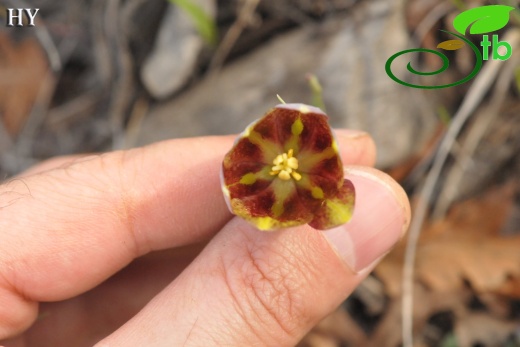Fritillaria arsusiana
Fritillaria arsusiana
Arsus lalesi
Bulb ovoid to broadly ovoid, 8–11 × 8–15 mm, with 1–3 bulblets; tunica pale brown, thin and papery. Stem 5–14 cm long, erect, smooth. Leaves 3–7, sessile, glaucous; lowest leaves 3.7–6.5 × 0.5–1.3 cm, alternate, lanceolate, lanceolate-elliptic, acute to obtuse; median leaves 2.5–5.5 × 0.15–0.7 cm, alternate, lanceolate-elliptic to linear-elliptic, acute to acuminate. Bracts 1, 2.0–4.1 × 0.1–0.3 cm, lanceolate, linear to linear-lanceolate, acuminate. Flowers 1–2. Perigone broadly campanulate, purple, purplish-brown, outer tepals sometimes yellow at the tips, inner tepals yellow at the tips and edges, rarely tessellated flowers. Outer tepals 18–28 × 5–6 mm, lanceolate, obtuse, ciliate-tufted at apex; inner tepals 18–28 × 8–10 mm, oblanceolate, obtuse, ciliate-tufted at apex. Nectaries 3.5–4 × 1.5–2.5 mm, ovate to broadly elliptic, green, purple around, placed 2.5–5 mm above tepal base. Filaments 6–8 mm long, thin, papillose, greenish-yellow; anthers 3–6 mm long, oblong, apiculate, yellow during anthesis but then brownish, dorsifixed. Style 7–10 mm long, minutely papillose, 3-lobed; lobes 2–3 mm long, smooth; stigma papillose. Capsule unknown.
Fritillaria arsusiana is a local putative endemic species restricted to the Amanos Mountains above Arsuz, İskenderun/Hatay in southern Anatolia. It colonizes only serpentine substrates at Pinus and Quercus openings, at an elevation of 1510–1550 m. Its flowering period is April to May.







